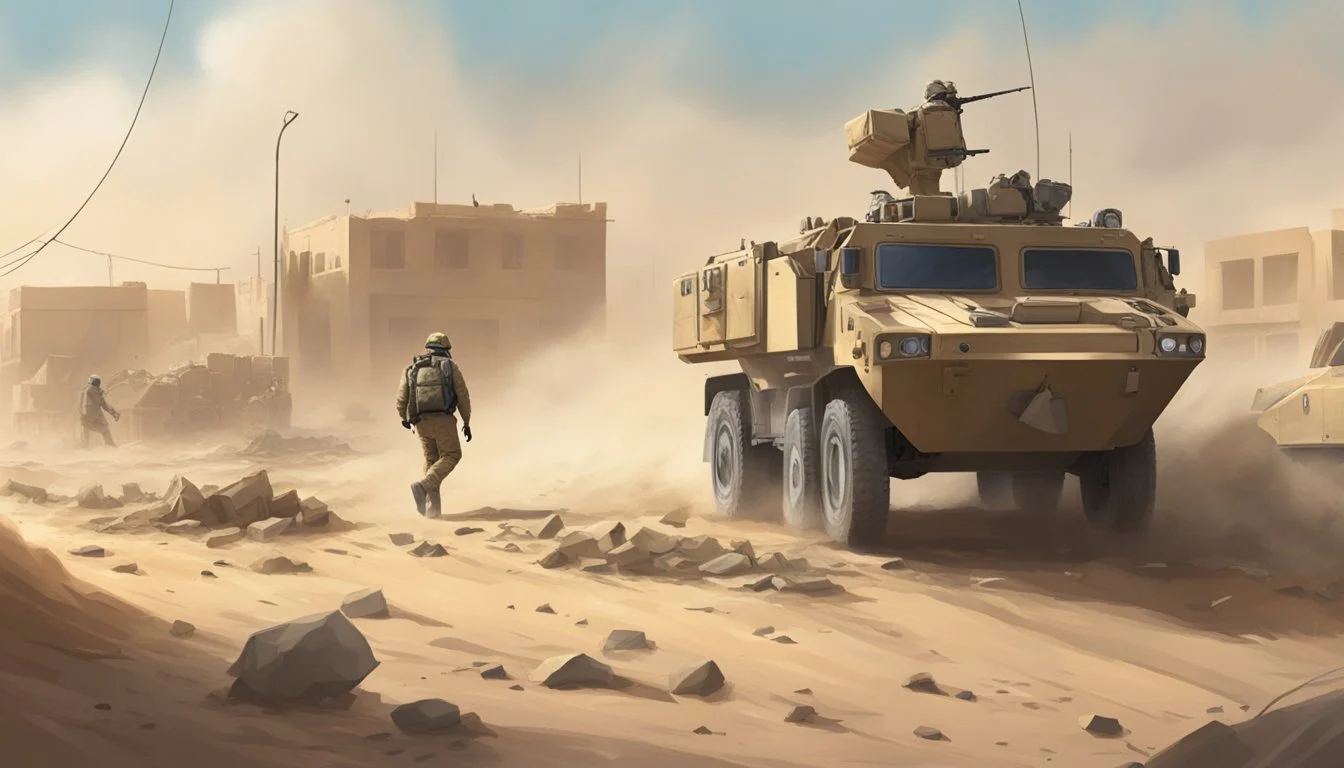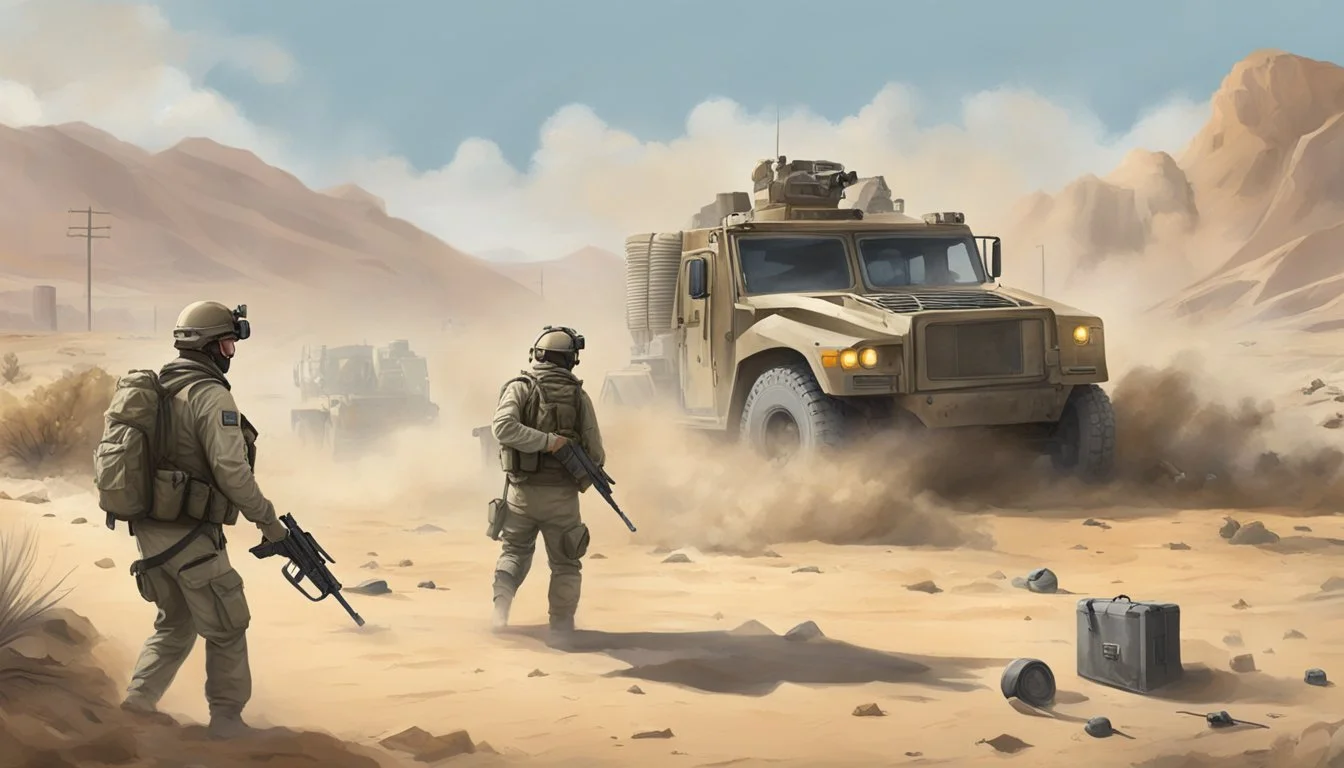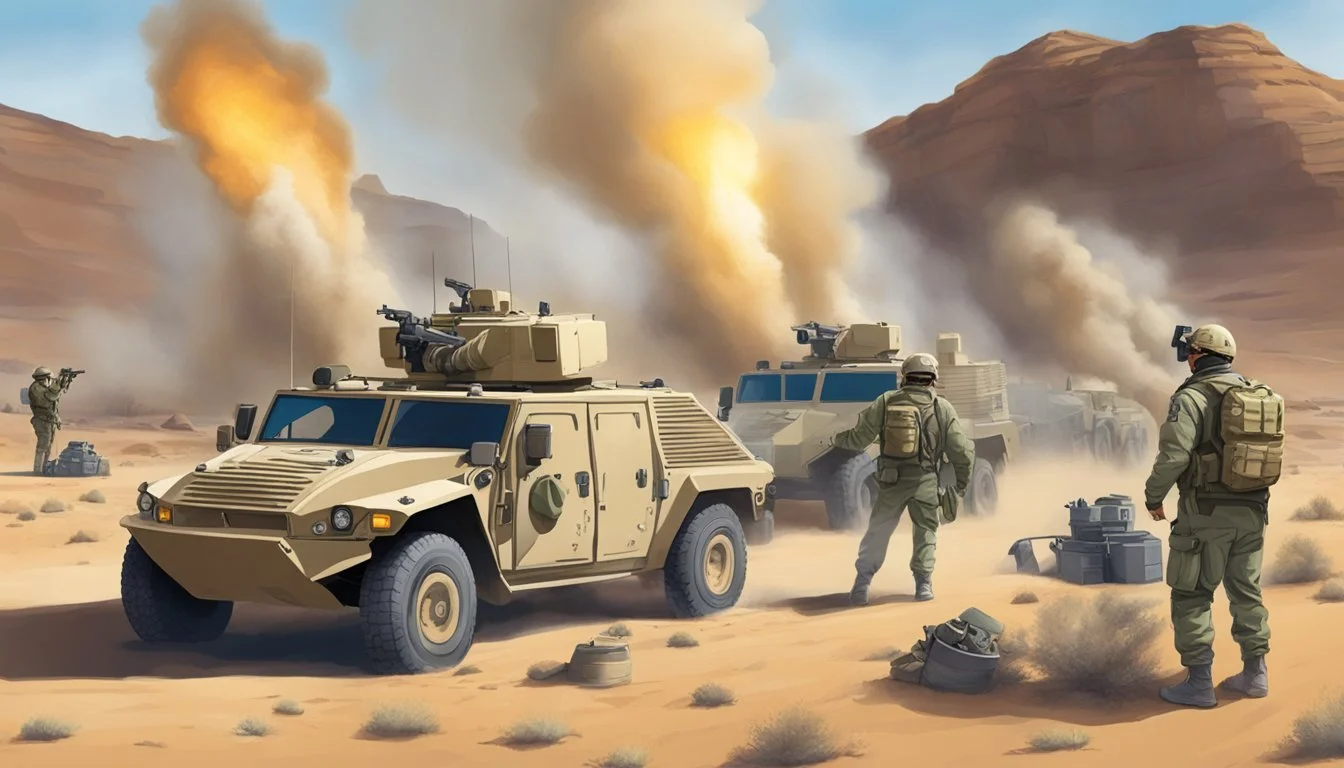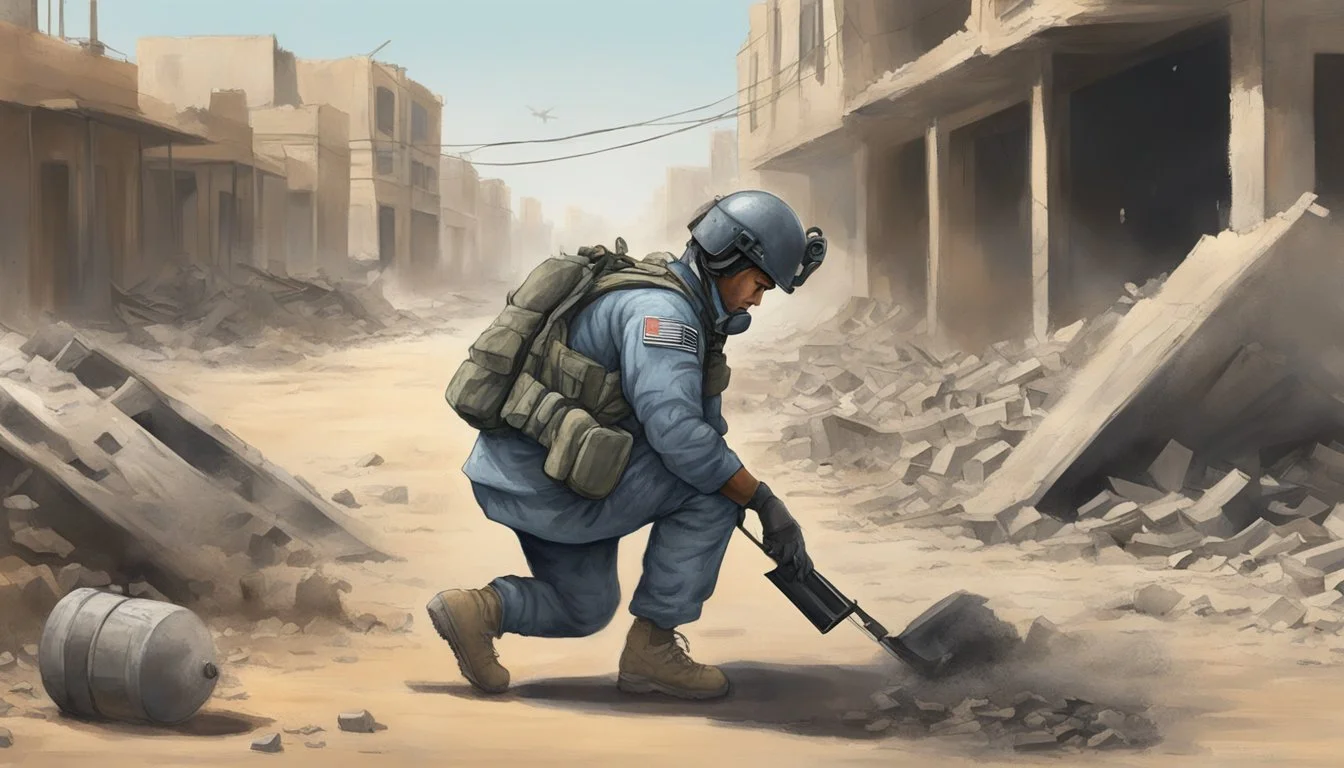The Genuine Hurt Locker
EOD Technicians in Iraq Face Daily Dangers
Explosive Ordnance Disposal (EOD) technicians in Iraq faced extraordinary challenges during the tumultuous years of conflict. These highly trained specialists put their lives on the line daily to neutralize improvised explosive devices (IEDs) and other deadly weapons. Their work was crucial for protecting both military personnel and civilians from the ever-present threat of hidden explosives.
The 2009 film "The Hurt Locker" brought widespread attention to the intense and perilous work of EOD teams in Iraq. While the movie took some creative liberties, it captured the essence of the extreme pressure and split-second decisions these technicians faced. The film's writer, Mark Boal, drew inspiration from his experiences as an embedded journalist with EOD units in Iraq in 2004.
Real EOD technicians operate with meticulous precision and adhere strictly to established protocols, unlike some of the more dramatic portrayals in the film. Their work requires extensive knowledge of explosives, advanced equipment, and unwavering focus. The genuine "hurt locker" refers to the mental and emotional toll of repeatedly confronting life-threatening situations while disarming bombs in hostile environments.
History of Explosive Ordnance Disposal (EOD)
Explosive Ordnance Disposal (EOD) has its roots in World War II, when the need for specialized units to handle unexploded ordnance became critical. These early EOD technicians faced dangerous tasks with limited equipment and training.
The post-war era saw significant advancements in EOD techniques and technology. Military branches developed dedicated EOD units to address the growing complexity of explosive threats.
In 1999, a pivotal moment occurred when the Naval School - Explosive Ordnance Disposal (NAVSCOLEOD) moved to Eglin Air Force Base, Florida. This relocation included the establishment of a permanent EOD Memorial.
The conflicts in Afghanistan and Iraq brought EOD to the forefront of military operations. EOD technicians played a crucial role in countering the threat of improvised explosive devices (IEDs).
The Army restructured its EOD units in response to these challenges. Detachments were converted into companies, supported by battalion and group headquarters. This change enhanced EOD capabilities and responsiveness on the battlefield.
EOD technicians continue to adapt to evolving threats. Their expertise now extends beyond traditional military ordnance to include chemical, biological, and nuclear hazards. Modern EOD teams utilize advanced robotics and protective equipment to safely neutralize a wide range of explosive dangers.
The Role of EOD Technicians in Iraq
Explosive Ordnance Disposal (EOD) technicians played a crucial role in Iraq, protecting both military personnel and civilians from dangerous explosives. These highly trained specialists were responsible for identifying, disarming, and disposing of various explosive devices.
EOD teams faced numerous challenges in the field, including improvised explosive devices (IEDs), unexploded ordnance, and booby traps. Their work required a combination of technical expertise, quick thinking, and nerves of steel.
In addition to their primary duties, EOD technicians often served as de facto infantrymen and forensic investigators. They collected evidence from explosive sites to help identify bomb makers and prevent future attacks.
The job of an EOD technician in Iraq was inherently dangerous. They operated in high-stress environments, knowing that a single mistake could be fatal. Despite the risks, these brave men and women saved countless lives through their dedication and skill.
EOD teams worked closely with other military units and Iraqi forces, providing essential support for combat operations and reconstruction efforts. Their expertise was crucial in clearing areas of explosive hazards, allowing for safer movement of troops and civilians.
The demanding nature of EOD work in Iraq took a significant toll on technicians. Many faced physical injuries and psychological stress due to the constant danger and pressure of their missions.
Training and Expertise of EOD Personnel
Explosive Ordnance Disposal (EOD) technicians undergo rigorous training and develop specialized expertise to handle dangerous explosives. Their skills are honed through extensive coursework, hands-on practice, and continuous learning of advanced techniques.
Basic EOD Training
EOD training begins with a comprehensive 9-month course at the Naval School Explosive Ordnance Disposal. Trainees learn fundamental skills in identifying, rendering safe, and disposing of various explosive devices. The curriculum covers chemistry, physics, and mathematics related to explosives.
Practical exercises simulate real-world scenarios, teaching trainees to handle conventional munitions, improvised explosive devices (IEDs), and chemical/biological threats. Physical fitness is emphasized, with trainees undergoing intense conditioning to prepare for the demanding nature of EOD work.
Graduates emerge with certifications in areas like underwater diving and parachuting, essential for diverse mission requirements.
Advanced Operational Techniques
EOD technicians continually refine their skills through specialized courses and on-the-job training. They learn advanced render-safe procedures for complex explosive devices and study emerging threats and technologies.
Training focuses on:
IED defeat tactics
Post-blast analysis
Robotic systems operation
Advanced electronics
Technicians also develop expertise in:
Forensic evidence collection
Tactical combat casualty care
Small unit tactics
Regular joint exercises with other military units and law enforcement agencies enhance interoperability and mission readiness.
Specialized Equipment Handling
EOD personnel become proficient in operating a wide array of specialized tools and protective equipment. They train extensively with:
Bomb suits
Remote-controlled robots
Portable X-ray systems
Explosive detection devices
Technicians learn to maintain and troubleshoot this equipment in field conditions. They also receive instruction on emerging technologies like:
Advanced imaging systems
Drone-based reconnaissance tools
AI-assisted threat analysis software
Hands-on practice ensures EOD teams can effectively deploy these tools in high-pressure situations, maximizing safety and mission success.
Challenges Faced by EOD Teams in Iraq
Explosive Ordnance Disposal (EOD) teams in Iraq confronted numerous hazards and obstacles in their critical mission. The harsh environment, evolving enemy tactics, and intense psychological pressures created a uniquely demanding operational landscape.
Terrain and Climate Difficulties
Iraq's diverse terrain posed significant challenges for EOD teams. Urban environments like Baghdad presented complex scenarios with crowded streets and buildings. Rural areas often had limited infrastructure, complicating transportation and equipment deployment.
The extreme climate added another layer of difficulty. Temperatures frequently soared above 120°F (49°C) in summer. This heat impacted equipment functionality and team performance. Heavy protective gear became even more burdensome in such conditions.
Sandstorms reduced visibility and interfered with communications. These events could delay or halt operations, leaving technicians vulnerable. Dust and sand also accelerated wear on sensitive equipment, requiring frequent maintenance.
Insurgent Tactics and IED Use
Improvised Explosive Devices (IEDs) became the signature weapon of insurgents in Iraq. These homemade bombs were often cleverly disguised and placed in high-traffic areas. EOD teams faced constant danger from secondary devices targeting first responders.
Insurgents continuously adapted their IED designs. They incorporated readily available materials and everyday objects as casings. This unpredictability required EOD technicians to stay vigilant and creative in their approach.
Remote detonation techniques evolved rapidly. Cell phones, garage door openers, and other common electronics were repurposed as triggers. This technological arms race demanded constant learning and adaptation from EOD teams.
Psychological Stress and Resilience
The high-stakes nature of EOD work exacted a heavy psychological toll. Each call potentially represented a life-or-death situation. The pressure to make split-second decisions while disarming explosives was immense.
Repeated exposure to danger led to cumulative stress. Many technicians experienced symptoms of post-traumatic stress disorder (PTSD). The loss of team members or witnessing civilian casualties compounded this mental strain.
Building resilience became crucial for long-term effectiveness. EOD teams developed strong bonds, relying on each other for support. Regular mental health check-ins and decompression periods were essential. Training programs increasingly incorporated stress management techniques to help technicians cope with the unique pressures of their role.
Operational Procedures and Protocols
Explosive Ordnance Disposal (EOD) technicians follow rigorous protocols to safely assess, contain, and neutralize explosive threats. Their procedures balance speed and caution to protect lives and infrastructure.
Threat Assessment and Approach
EOD teams carefully evaluate each situation before taking action. They gather intelligence from multiple sources, including visual observation, remote sensors, and local reports. Technicians analyze the type of device, its location, and potential triggering mechanisms.
The approach phase involves cautious movement toward the explosive. Teams use armored vehicles when possible and employ remote-controlled robots to conduct initial inspections. Technicians wear specialized bomb suits that offer protection but limit mobility and visibility.
EOD personnel maintain constant communication with command centers and support units throughout the approach. They establish a safety cordon to keep civilians and non-essential personnel away from the danger zone.
Incident Containment Strategies
Once on scene, EOD teams implement containment measures to limit the potential impact of an explosion. They evacuate surrounding areas and set up blast mitigation equipment like sand berms or water barriers.
Technicians carefully document the scene, taking photographs and noting key details about the device and its environment. This information aids in safe disposal and supports later forensic analysis.
In some cases, EOD personnel may attempt to disrupt radio signals or jam frequencies to prevent remote detonation. They also assess risks to critical infrastructure and take steps to protect vulnerable targets.
Neutralization and Disposal
EOD technicians use various techniques to render explosives safe. These may include controlled detonations, chemical neutralization, or manual disarming. The chosen method depends on the device type, location, and urgency of the situation.
Remote-controlled robots often play a crucial role in neutralization efforts. These machines can place disruptors or cut wires without risking human lives. For complex devices, technicians may need to approach and work manually, using specialized tools and steady hands.
After neutralization, EOD teams carefully collect evidence for intelligence purposes. They transport any remaining materials to secure locations for final disposal. Thorough post-incident reports help improve future operations and tactics.
Technological Innovations and Robotics
Explosive Ordnance Disposal (EOD) teams in Iraq benefited from significant technological advancements. These innovations improved safety and effectiveness in dealing with hazardous devices.
Bomb Disposal Robots
Robotic systems became essential tools for EOD technicians in Iraq. These remotely operated machines allowed teams to inspect and neutralize explosive devices from a safe distance. Common models included the iRobot PackBot and the Talon robot.
Equipped with cameras, manipulator arms, and sensors, these robots could navigate rough terrain and tight spaces. They provided real-time video feeds and allowed operators to manipulate objects precisely.
Some advanced robots featured multiple cameras, giving operators a 360-degree view of the environment. This capability proved crucial in complex urban settings where threats could come from any direction.
Remote Sensing Equipment
EOD teams utilized sophisticated detection and imaging technologies to identify and assess potential threats. Ground-penetrating radar systems helped locate buried explosives without disturbing the soil.
X-ray devices allowed technicians to examine suspicious packages or vehicles non-invasively. Portable chemical detectors could identify explosive compounds from trace amounts in the air.
Thermal imaging cameras detected heat signatures that might indicate active explosive devices or recently planted ones. These tools enhanced the teams' ability to gather critical information while minimizing risk.
Protective Gear Advances
Modern EOD suits offered improved protection and mobility compared to earlier designs. Made with advanced materials like Kevlar and ceramic plates, these suits could withstand significant blast forces and shrapnel.
Helmets incorporated communication systems and heads-up displays, providing vital information to technicians. Cooling systems within the suits helped mitigate heat stress in Iraq's extreme temperatures.
Lightweight yet strong materials reduced the overall weight of protective gear, allowing for greater maneuverability. This balance of protection and mobility was crucial for EOD technicians working in high-stress environments.
Cooperation with Military Units and Agencies
EOD technicians in Iraq worked closely with various military and civilian organizations to carry out their critical missions. This collaboration enhanced overall operational effectiveness and safety in the complex warzone environment.
Joint Missions with Armed Forces
EOD teams frequently partnered with infantry, special forces, and other combat units on dangerous missions. They cleared routes of IEDs before patrols and convoys. EOD techs also supported raids on bomb-making facilities, providing expertise to safely neutralize explosives.
During major offensives, EOD units were embedded with frontline forces. They quickly responded to IED threats, allowing operations to continue with minimal disruption. This close integration saved countless lives and was vital to mission success.
EOD teams trained other soldiers on IED awareness and basic counter-IED techniques. This multiplied their impact and helped all troops operate more safely in the IED-laden environment.
Collaboration with Intelligence Divisions
EOD techs worked hand-in-hand with military intelligence units to gather and analyze information on insurgent bomb-making activities. They carefully documented IED components and construction methods found in the field.
This data helped intelligence analysts identify bomb-making cells and track the flow of IED materials. EOD teams also participated in sensitive site exploitation missions, collecting evidence from bomb factories and weapons caches.
Their technical expertise was crucial in developing countermeasures against new and evolving IED designs. EOD units received intelligence briefings to stay ahead of insurgent tactics and anticipate emerging threats.
Interactions with Civilian Authorities
EOD technicians coordinated closely with Iraqi police and civil defense forces on bomb disposal operations in urban areas. They mentored Iraqi EOD units, helping build local capacity to handle explosive threats.
Teams responded to civilian reports of unexploded ordnance, working to make neighborhoods safe. EOD techs conducted community outreach programs, educating locals on explosives risks and reporting procedures.
During elections and other high-profile events, EOD units partnered with Iraqi security forces to sweep venues and protect civilian gatherings from terrorist attacks. This cooperation was essential in fostering trust and stability.
Case Studies of Successful EOD Operations
EOD technicians in Iraq faced countless high-stakes situations during their deployments. Their expertise saved many lives through careful defusal of improvised explosive devices (IEDs).
One notable operation took place in Baghdad in 2006. An EOD team successfully disarmed a complex vehicle-borne IED near a crowded marketplace, preventing mass civilian casualties.
In Fallujah in 2004, technicians safely disposed of a cache of unexploded ordnance discovered in a school building. This allowed classes to resume without risk to students and staff.
A 2007 mission in Mosul showcased EOD ingenuity. The team used a remote-controlled robot to investigate and neutralize a suspected IED, keeping personnel out of harm's way.
Some key statistics on EOD operations in Iraq:
Over 190,000 IEDs neutralized between 2003-2011
Approximately 20-30 IED calls per day at peak periods
EOD teams responded to 250,000+ total explosive hazards
These examples highlight the critical role EOD technicians played in protecting both military personnel and Iraqi civilians throughout the conflict.
Impact of EOD Work on the Iraq Conflict
Explosive Ordnance Disposal (EOD) technicians played a crucial role in the Iraq conflict. Their work significantly reduced casualties among both military personnel and civilians.
EOD teams neutralized countless improvised explosive devices (IEDs) planted by insurgents. This helped maintain safe routes for supply convoys and troop movements throughout the country.
The presence of EOD units allowed for more effective urban operations. By clearing buildings and areas of explosive hazards, they enabled other military units to operate with greater safety and efficiency.
EOD technicians' expertise extended beyond defusing bombs. They also gathered valuable intelligence on insurgent tactics and bomb-making techniques, which informed broader military strategy.
The visibility of EOD teams had a psychological impact on both sides of the conflict. For coalition forces, it provided a sense of security. For insurgents, it presented a significant obstacle to their tactics.
EOD work contributed to stabilization efforts by making areas safer for reconstruction projects and civilian activities. This was essential for rebuilding infrastructure and restoring normal life in conflict-affected regions.
The technical skills and bravery of EOD technicians earned respect from Iraqi security forces. This facilitated knowledge transfer and capacity building, which was crucial for long-term security in Iraq.
Legacy and Future of EOD Technicians
Explosive Ordnance Disposal (EOD) technicians have left an indelible mark on military operations in Iraq and beyond. Their courage and expertise have saved countless lives by neutralizing dangerous explosives.
During the Iraq War, EOD teams faced unprecedented challenges from improvised explosive devices (IEDs). This experience rapidly advanced EOD tactics, techniques, and technologies.
The skills honed in Iraq continue to shape EOD training and operations today. Modern EOD technicians benefit from lessons learned and innovations developed during that conflict.
Looking ahead, EOD teams are preparing for evolving threats in diverse environments. They are expanding their capabilities beyond traditional bomb disposal to address emerging hazards.
Key areas of focus for future EOD operations include:
• Counter-WMD operations • Unmanned/robotic systems • Advanced protective equipment • Forensic and intelligence gathering
EOD units are also emphasizing greater integration with other military and civilian agencies. This collaborative approach aims to enhance overall explosive threat response.
As warfare evolves, so too will the role of EOD technicians. Their adaptability and expertise will remain crucial for safeguarding both military personnel and civilians worldwide.








